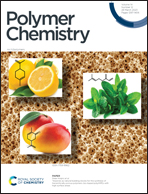Flexibility-driven 1D-structural preference in a bis-terpyridine-Fe(ii)-metallo-supramolecular polymer possessing potential tricolor electrochromism†
Abstract
The recent advancement of metallo-supramolecular polymeric (MSP) complexes using terpyridine (TPY) chelating ligands with a linear or angular spacer is appealing. Still, architectural (linear/cross or cyclic) tuning is challenging. Ditopic angular TPY ligands with a carbazole or triphenylamine spacer creating metallocycles with Fe2+ have been identified earlier. This paper introduces a more flexible and electron-rich N-heptyldiphenylamine as a spacer for an angular ditopic TPY ligand that contrarily affords a 1-D linear polymer, as revealed from SEM and STM experiments along with partial support of 1H-NMR. Notably, the formation of such a thermodynamically unfavored linear polymer is rare. Based on the single crystal X-ray and DFT-optimized ligand structure, TPY units are widely separated (∼67°) due to conformational and electronic diversity, leading to the control of the structural variation of the MSP. The absorption spectrum indicated a metal–ligand charge transfer, but emissions were mainly centered on the ligand part. However, the presence of this redox-active diphenylamine and Fe2+ centers enables this 1D MSP to be a potential candidate for electrochromism within a possible window of +2.8 V to −1.5 V. A tricolor electrochromic device was prepared with this MSP that exhibited rapid color switching with a bleaching and coloration time (s) of 2.3 and 1.8, respectively, with a coloration efficiency of 180 cm2 C−1. The unchanged 50% optical contrast of this device, even after 500 cycles, is commendable. The involvement of the ligand along with Fe2+ in the overall redox process was identified. Hence, this result would recognize a new approach for varying the architectural motifs of MSPs using a more flexible electron-rich spacer. Finally, an efficient tri-color electrochromic device was invented for real-life applications.



 Please wait while we load your content...
Please wait while we load your content...